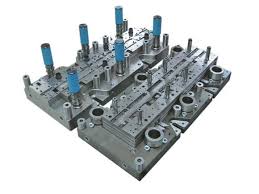What Is the Mold Stamping Process?
Stamping is a forming processing method that relies on presses and dies to apply external force to sheets, strips, tubes, and profiles, causing them to undergo plastic deformation or separation, thereby obtaining workpieces (stamped parts) with the required shapes and dimensions.
Automobile bodies, chassis, fuel tanks, radiator fins, boiler steam drums, container shells, motor and electrical steel sheets, etc., are all produced by stamping. Instruments, household appliances, bicycles, office machinery, daily utensils, and other products also incorporate a large number of stamped parts.

Stamping can be classified into hot stamping and cold stamping based on processing temperature. The former is suitable for processing sheets with high deformation resistance and poor plasticity, while the latter is commonly used for stamping thin sheets at room temperature.
The three essential elements of stamping processing are materials, dies, and equipment.
Materials: The surface and internal properties of the materials used for stamping have a significant impact on the quality of stamped products.
Six requirements for stamping materials:
1. Accurate and uniform thickness.
2. Smooth surface, free from spots, scars, scratches, or surface cracks, to prevent the generation of defective products.
3. Uniform yield strength without obvious directional characteristics to reduce the production of defective or scrap products.
4. High uniform elongation to prevent uneven deformation.
5. Low yield strength ratio to improve the accuracy of bent parts.
Additional resources:The Ultimate Buyer's Guide for Purchasing China OPP bag for packaging frozen yogurt
The Cotton Bag Company – Custom Manufacturing
3 Side Seal Pouch | Printed Side Seal Pouches And Bags
Kraft Paper Mailers
6. Low work hardening to prevent future deformation.
Dies
The precision and structure of the dies directly affect the forming and accuracy of stamped parts. The manufacturing cost and service life of dies are significant factors affecting the cost and quality of stamped parts.
Equipment
According to the transmission structure: manual presses, mechanical presses, hydraulic presses, pneumatic presses, high-speed mechanical presses, CNC presses.
According to processing accuracy: ordinary presses, precision presses.
According to the scope of use: ordinary presses, special presses.
Processing characteristics
1. Stamping has high production efficiency, is easy to operate, and is conducive to mechanization and automation.
2. Stamped parts have stable quality, good interchangeability, and feature "identical molds."
3. Stamping has high strength and rigidity.
4. The cost of stamped parts is relatively low.

Comments
0